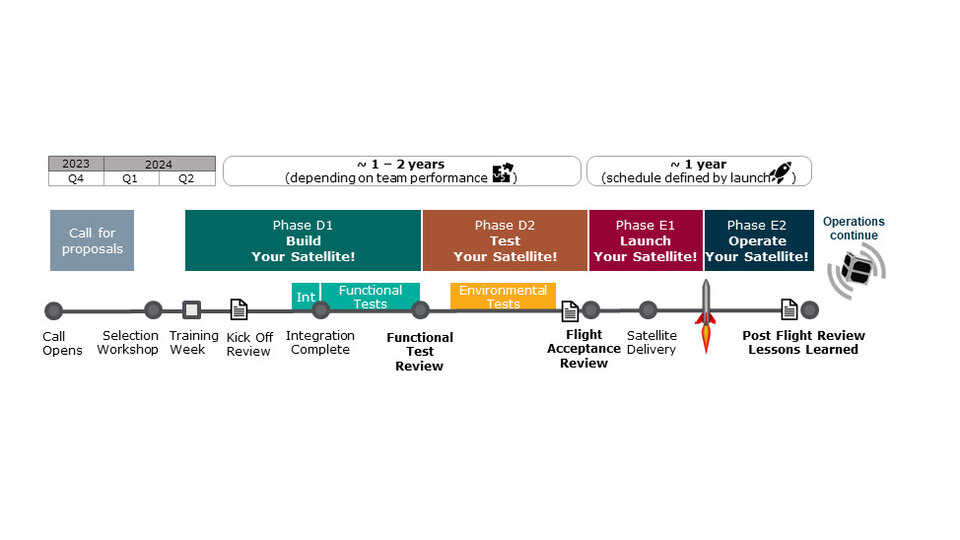Fly Your Satellite Programme Phases
The Fly Your Satellite! programme consists of four programme phases, that follow the typical development cycle of a space mission, but which are tailored to better fit the scope of university or tertiary education institution projects. The duration of the phases depends on the satellite team performance, complexity of the mission and the launch opportunity.
Phase D1 ‘Build Your Satellite!’
Duration: 0.5 – 1.5 years
Upon selection, students are invited to a Training Workshop followed by a Kick-Off Review to help consolidate the satellite AIV plan. Teams complete the manufacturing, assembly, and integration of their spacecraft. Once the satellite is fully assembled, the dimensional and physical requirements are verified, and an inspection is performed. This is followed by the functional test campaign of the system: All functions are tested in all operational modes and a mission test is conducted to simulate the mission as close as possible to the ‘real life’ in-orbit conditions. Furthermore, it is demonstrated that the satellite can communicate and be operated by its ground segment. The phase concludes with a successful Functional Test Review (FTR).
Phase D2 ‘Test Your Satellite!’
Duration: 0.5 – 1 year
During this phase, the teams will execute environmental testing on their satellites, including vibration and thermal vacuum/ thermal cycling tests, for which ESA’s Education Office offers the use of dedicated test facilities at ESEC Galaxia. Other environmental tests may be needed based on the mission. By the end of this phase, the team should successfully pass the Flight Acceptance Review (FAR) by completing their verification campaign, and demonstrating that the satellite (flight and ground segment) fully meets all applicable requirements before being awarded their 'ticket to orbit!' which grants access to the Launch Your Satellite! phase.
Phase E1 ‘Launch Your Satellite!’
Duration: 3 – 6 months
Teams admitted to this phase are offered a launch opportunity by ESA. Teams will then perform all the activities at space and ground segment level necessary to prepare for the launch of the satellite. The spacecrafts will be delivered and installed inside orbital deployers, and may undertake a campaign of integrated tests (to be performed in accordance with the requirements from the launch organisation), the flight hardware will be shipped to the launch site in time for the launch campaign.
Before launch, teams may pass additional reviews required by the launch authority. The phase concludes with the deployment of the satellites into orbit.
Phase E2 ‘Operate Your Satellite!’
Duration: > 6 months
Once in orbit, checkouts of the satellite are conducted and the nominal operations begin. Teams operate their satellite from their own ground stations and gather the data obtained from their mission. This phase, and with it the participation in the programme, concludes with a ‘post flight review & lessons learned’ workshop at ESA.
Student teams will share their experiences and results from their mission through participation in conferences, for which they can be supported by ESA’s Education Office.
Note: Scheduling of Launch Opportunities
Launch opportunities are regularly explored by the FYS programme and matched to the technical status of the teams. Opportunities are selected once there is good confidence that the team can successfully complete the final verification activities of the system (functional and environmental test campaigns).
One of the FYS objectives is to increase the chances for mission success through careful verification and proper documentation. As such, a scheduling approach with sufficient margins is preferred over unrealistic schedules, in which aggregated delays may lead to compressing the system level tests (both functional and environmental), resulting in a higher risk profile. Accelerated test campaigns have been flagged by some developers as a potential root cause for mission failure or in-orbit malfunctions. Therefore, it is important that teams are realistic with their planning and capabilities, to ensure that the space and ground segment verification is conducted systematically in accordance with the team’s available resources.


